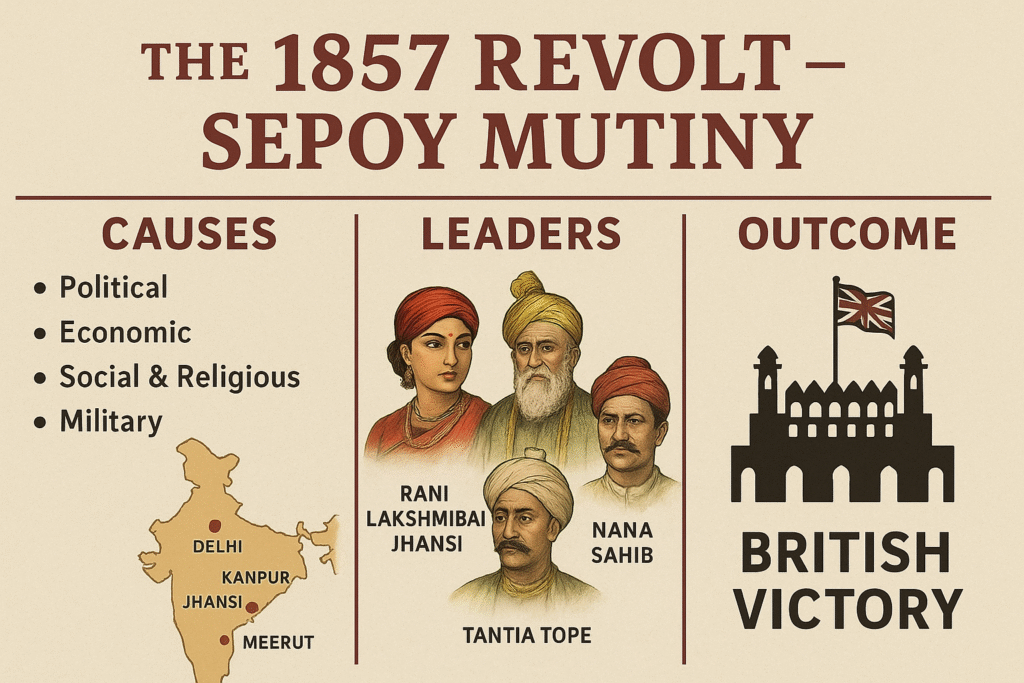Dive into the fascinating story of the 1857 Revolt, often referred to as the Sepoy Mutiny — a pivotal moment in India’s fight against British colonial rule.
Introduction
The 1857 Revolt, also known as the Sepoy Mutiny or the First War of Indian Independence, marked a significant chapter in India’s quest for freedom. It started as a rebellion among Indian soldiers (sepoys) serving the British East India Company but quickly escalated into a broader uprising. While the British ultimately quelled the revolt, its effects resonated deeply within India’s national identity for years to come.
Causes of the 1857 Revolt
- Political Causes
- The Doctrine of Lapse allowed the British to annex princely states without a male heir (e.g., Jhansi, Satara, Nagpur).
- Disrespect towards traditional rulers and their titles.
- Economic Causes
- Heavy taxation and exploitation of peasants.
- Decline of Indian handicrafts due to British industrial imports.
- Social & Religious Causes
- Laws like the abolition of sati and promotion of widow remarriage were seen as interference in traditional customs.
- Missionary activities created fear of forced religious conversion.
- Military Causes
- Indian sepoys faced discrimination in pay and promotions.
- The introduction of the Enfield rifle cartridges, rumored to be greased with cow and pig fat, deeply offended Hindu and Muslim soldiers.
Immediate Cause – The Enfield Rifle Incident
In 1857, the British introduced the new Enfield rifle. Sepoys had to bite open cartridges allegedly coated with cow and pig fat, violating their religious beliefs. When soldiers at Meerut refused to use them, they were punished — sparking open rebellion on 10 May 1857.
Timeline & Spread of the 1857 Revolt
- Meerut – Revolt begins as sepoys kill British officers.
- Delhi – Bahadur Shah Zafar declared Emperor of Hindustan.
- Kanpur – Led by Nana Sahib.
- Jhansi – Defended by Rani Lakshmibai.
- Lucknow – Begum Hazrat Mahal leads resistance.
- Bihar – Kunwar Singh fights against British forces.
Major Leaders of the Sepoy Mutiny
- Bahadur Shah Zafar – Symbolic head of the revolt.
- Rani Lakshmibai of Jhansi – Icon of bravery.
- Nana Sahib – Maratha leader and rebel commander.
- Tantia Tope – Master of guerrilla warfare.
- Begum Hazrat Mahal – Leader in Awadh.
- Kunwar Singh – Veteran leader from Bihar.
Why the Revolt Failed
- Lack of unified leadership and coordination.
- Limited geographical spread (mainly North & Central India).
- British superiority in weapons and military strategy.
- Some Indian rulers sided with the British.
Consequences of the 1857 Revolt
- End of East India Company rule – India brought under direct Crown rule through the Government of India Act, 1858.
- Reorganization of the army – Fewer Indians, more Europeans in the forces.
- Policy shift – British avoided direct interference in Indian social and religious matters.
- Rise of nationalism – Inspired future freedom movements.
Legacy
Though unsuccessful, the 1857 Revolt was the first united stand against British imperialism. It showcased the courage of leaders like Rani Lakshmibai and Tantia Tope, whose sacrifices became a source of inspiration for later generations.

FAQ on the 1857 Revolt
Q1: What is the 1857 Revolt also known as?
The revolt is known as the Sepoy Mutiny, the Indian Mutiny, and the First War of Indian Independence.
Q2: Who were the leaders of the 1857 Revolt?
Rani Lakshmibai, Bahadur Shah Zafar, Nana Sahib, Tantia Tope, Begum Hazrat Mahal, and Kunwar Singh.
Q3: What was the immediate cause of the revolt?
The introduction of Enfield rifle cartridges allegedly greased with cow and pig fat.
Q4: What was the outcome of the revolt?
The revolt was crushed, but it led to the end of East India Company rule and direct governance by the British Crown.

Thanks for your article. I would also love to say a health insurance agent also works for the benefit of the actual coordinators of a group insurance policy. The health insurance agent is given a summary of benefits desired by anyone or a group coordinator. Such a broker does indeed is seek out individuals or even coordinators that best go with those demands. Then he provides his advice and if both parties agree, the broker formulates a legal contract between the 2 parties.
https://bonusbacklinks.com/
Excellent post. I was checking constantly this blog and I am impressed! Extremely helpful information particularly the last part 🙂 I care for such info a lot. I was looking for this particular information for a very long time. Thank you and good luck.
https://www.zoritolerimol.com